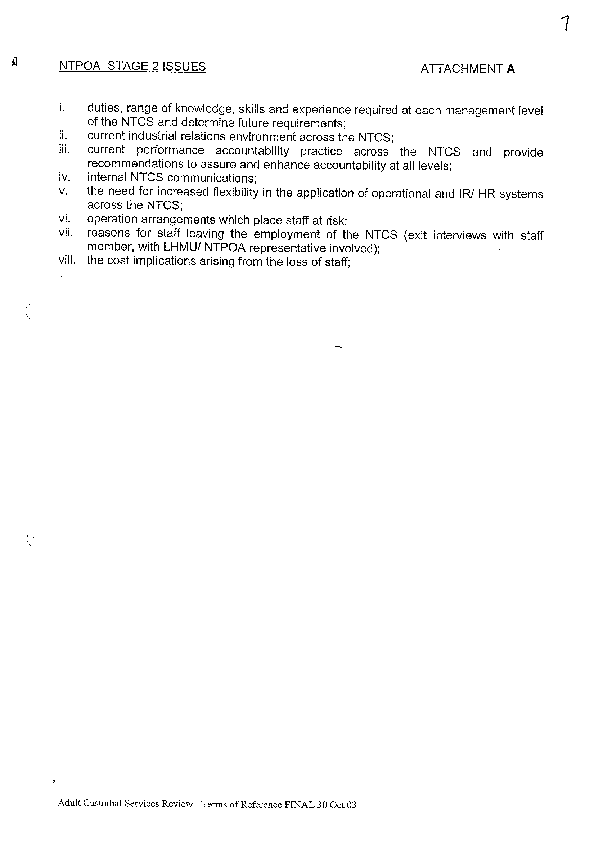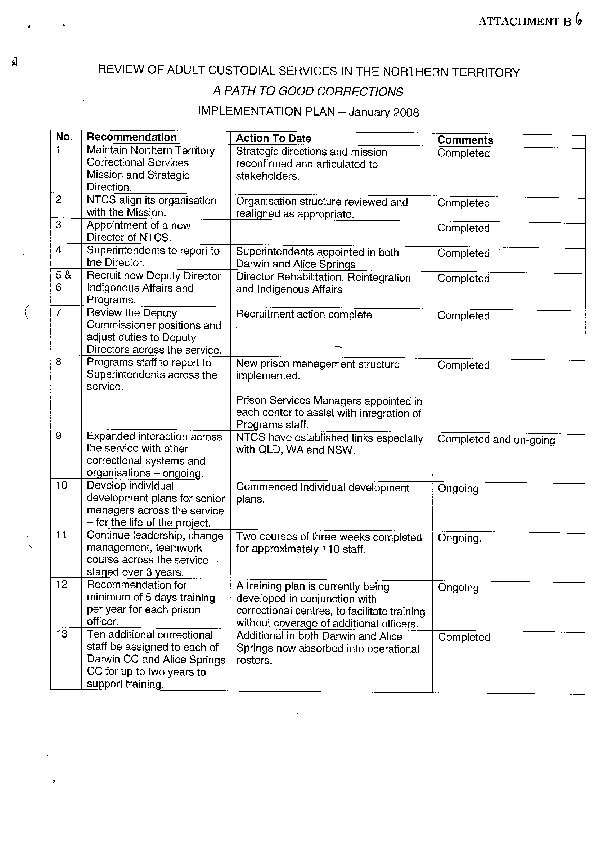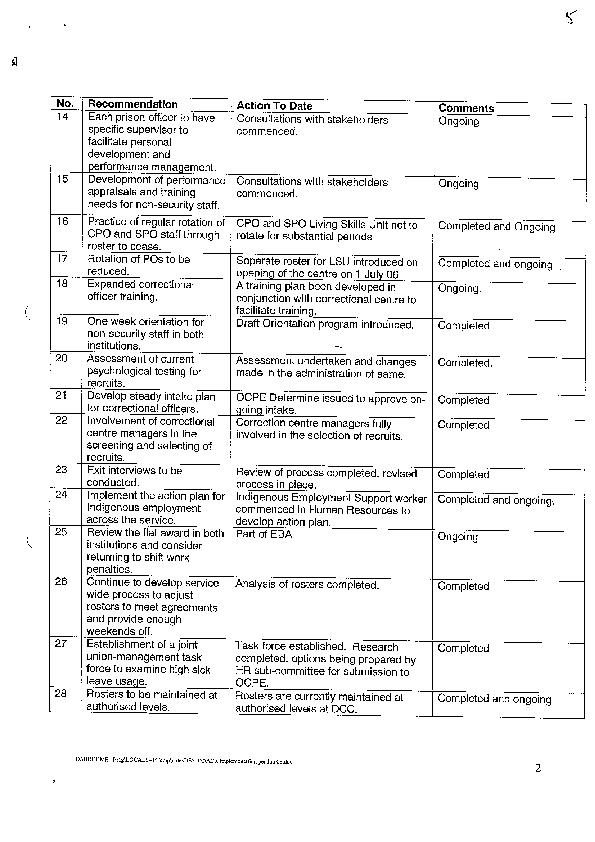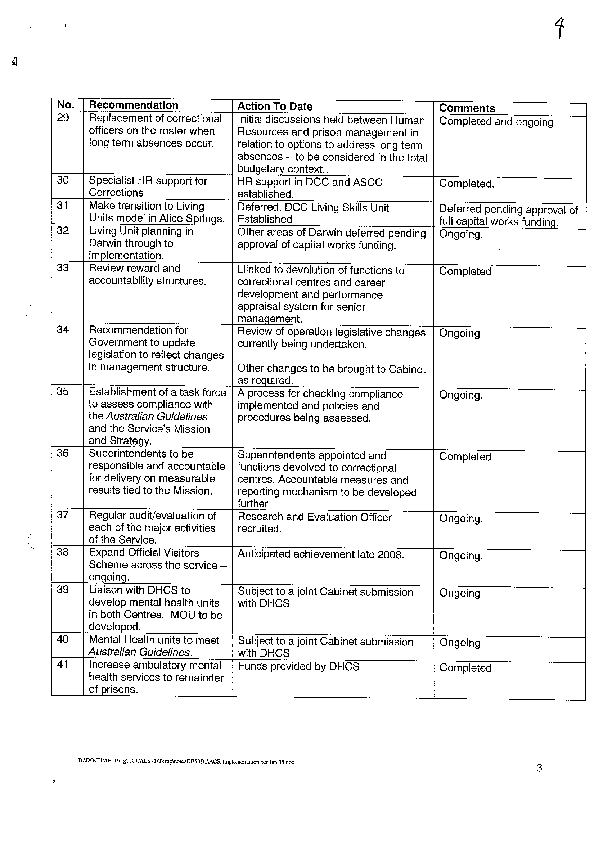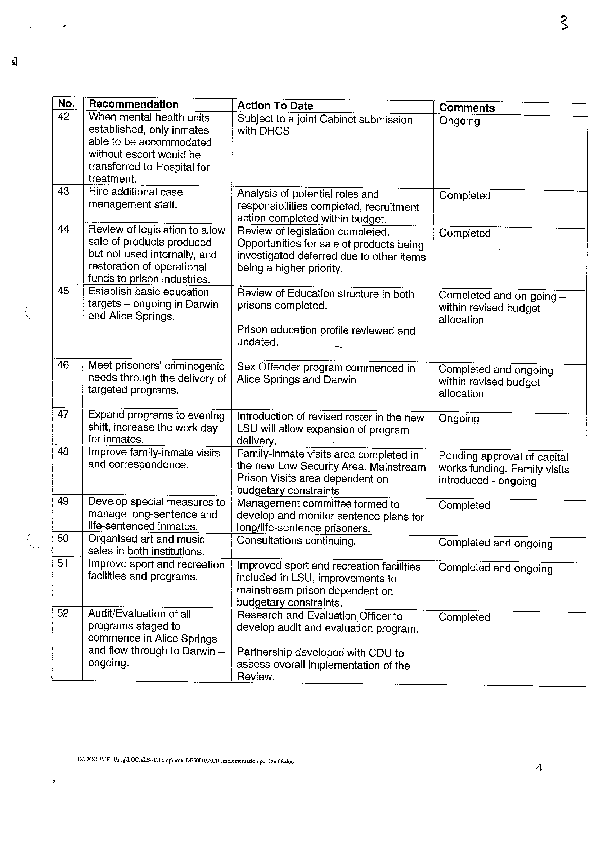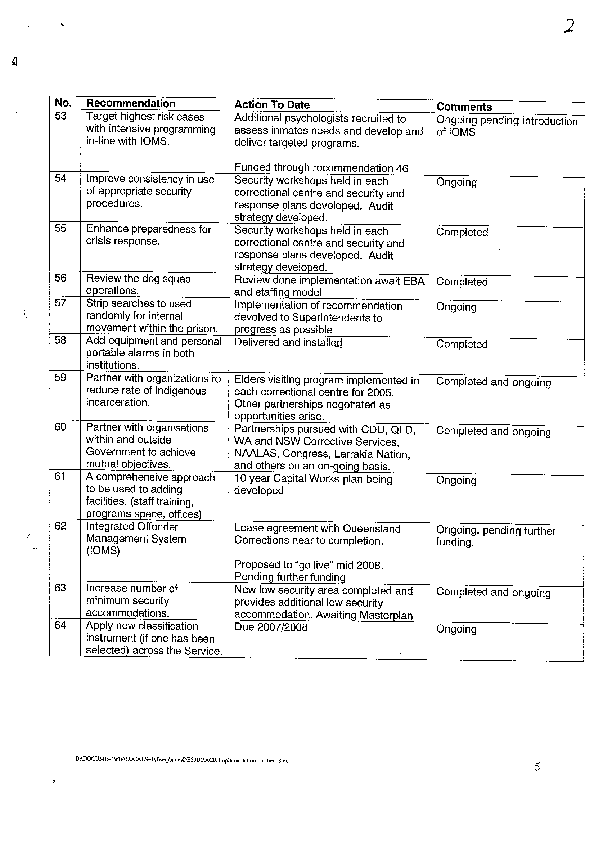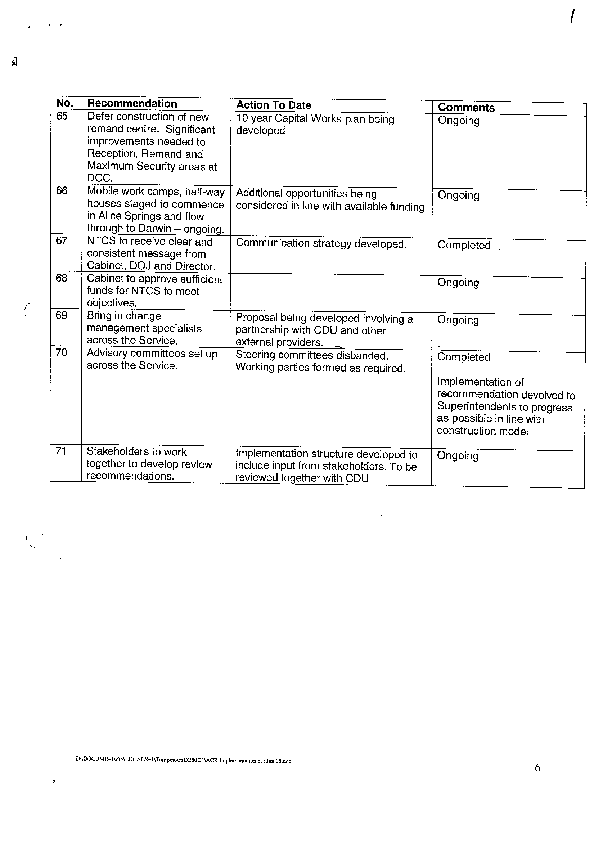Correctional Services - Prison and Custodial Services
WRITTEN QUESTIONS
10th Assembly
19/07/2007
263. Correctional Services - Prison and Custodial Services
Ms Carney to for Minister for Justice and Attorney-General
QUESTION
- (Please note “Berrimah” refers to the Correctional Services facility in the Top End; “Alice Springs” refers to the Correctional Services facility in Alice Springs).
1. What is the average per meal cost of food provided at Berrimah; and Alice Springs?
2. What is the average per meal cost of food provided at each of the watch houses?
3. How many staff are employed at Berrimah and Alice Springs, and please provide details of the levels at which each staff are employed?
4. How many Prison Officers (“officers”) are there now working, or rostered to work at Berrimah and Alice Springs?
5. How many officers were working, or rostered to work at the same time last year at Berrimah and Alice Springs?
6. What is the prisoner capacity at Berrimah?
7. What is the prisoner capacity at Alice Springs?
8. What is the optimum prisoner to staff ratio in Berrimah and Alice Springs?
9. The Alice Springs jail was built for 400 prisoners, but there has been an agreement between the department and prison officers to ensure it runs safely with 450 prisoners. Please provide details of that agreement, as well as the number of prison officers required if prisoner numbers are between 400 and 450?
10. Does this agreement involve the ability to call in more staff if prisoner numbers exceeded 400? How does it work; how many times have staff had to be called in?
11. Is there a similar agreement in place for Berrimah, and if so, what are the details of such on agreement?
12. How many times have more staff been called into work as a result of overcrowding?
13. How many times has Alice Springs operated where there have been over 400 prisoners and not enough staff?
14. How many times has Berrimah operated where there has been prisoners over the Berrimah capacity level?
15. In Alice Springs, is it the case that there are 138 prison officers currently rostered to work at Alice Springs? If so, is that sufficient for 400 prisoners? If not, what is the number?
16. Isn’t it the case that Alice Springs and Berrimah are regularly understaffed?
17. How many shifts have been understaffed in 2006/07 at Berrimah and Alice Springs?
18. How many prison officers retired or resigned from Alice Springs and Berrimah in 2006/07 and how does that compare with the preceding two years?
19. How many new recruits were there in 2006/07 and how does that compare with the preceding two years?
20. How many times has the department advertised for new officers? What form did the advertising take, where did it occur, and what has been the cost?
21. How many times do you expect to advertise for prison officers in 2007/08?
22. How much was spent on all forms of advertising in 2006/07, and how does that compare with the preceding 2 years? Is there an advertising budget? Will there be more ads in 2007/08?
23. Understaffing and other staff issues lead to the Cayer review commissioned a couple of years ago: Have the issues that lead to the review been resolved, and if not, please outline issues that remain unresolved?
24. Please outline what parts of the Cayer review have not been implemented, and provide reasons as to why that is the case?
25. What has happened to the money allocated as a result of the Cayer review?
26. The draft Tungsten report provided to Government in 2004, recommend at page 2 that ‘a new high security correctional facility will be needed in Darwin by 2014 and planning should commence for this in the next 3 years’: Has planning commenced, and if not, why not?
27. Given the current focus on child abuse: Is it reasonable to expect that more offenders will be charged and sentenced in the future? If so, how will Berrimah and Alice Springs handle significantly more prisoner numbers, and what plans do you have in place to deal with this issue?
28. Is it expected, on the basis of the advice provide to you by the DPP about the increase in the number of files; and the increase in the number of WAS clients: That the prisoner numbers will continue to grow in any event, and that Berrimah and Alice Springs will not have the space to accommodate them.
29. What plans do you have in place to deal with prisoner numbers increasing, based on all of the indications you have available to you?
30. Please provide details about the sex offender programs at Alice Springs and Darwin, and include:
a. What do they involve?
b. How many staff are involved; how is success measured?
c. What is the nature of the programs?
d. Who runs the programs and what are their qualifications?
e. When did they start; when did they finish; and explain the reasons for any cessation in delivery?
f. How much did each program cost?
g. Provide any other relevant information about the programs.
31. Does the 2007/08 budget include any additional funding for sex offender programs at Berrimah or Alice Springs? If not, why not?
32. Have the sex offender programs which have operated to date been adequate, and do you expect the number of programs to increase?
ANSWER
Answered on 14/03/2008
(Please note “Berrimah” refers to the Correctional Services facility in the Top End; “Alice Springs” refers to the Correctional Services facility in Alice Springs).
1. What is the average per meal cost of food provided at Berrimah; and Alice Springs?
2. What is the average per meal cost of food provided at each of the watch houses?
3. How many staff are employed at Berrimah and Alice Springs, and please provide details of the levels at which each staff are employed?
4. How many Prison Officers (“officers”) are there now working, or rostered to work at Berrimah and Alice Springs?
5. How many officers were working, or rostered to work at the same time last year at Berrimah and Alice Springs?
6. What is the prisoner capacity at Berrimah?
7. What is the prisoner capacity at Alice Springs?
8. What is the optimum prisoner to staff ratio in Berrimah and Alice Springs?
9. The Alice Springs jail was built for 400 prisoners, but there has been an agreement between the department and prison officers to ensure it runs safely with 450 prisoners. Please provide details of that agreement, as well as the number of prison officers required if prisoner numbers are between 400 and 450?
10. Does this agreement involve the ability to call in more staff if prisoner numbers exceeded 400? How does it work; how many times have staff had to be called in?
11. Is there a similar agreement in place for Berrimah, and if so, what are the details of such on agreement?
12. How many times have more staff been called into work as a result of overcrowding?
13. How many times has Alice Springs operated where there have been over 400 prisoners and not enough staff?
14. How many times has Berrimah operated where there has been prisoners over the Berrimah capacity level?
15. In Alice Springs, is it the case that there are 138 prison officers currently rostered to work at Alice Springs? If so, is that sufficient for 400 prisoners? If not, what is the number?
16. Isn’t it the case that Alice Springs and Berrimah are regularly understaffed?
17. How many shifts have been understaffed in 2006/07 at Berrimah and Alice Springs?
18. How many prison officers retired or resigned from Alice Springs and Berrimah in 2006/07 and how does that compare with the preceding two years?
19. How many new recruits were there in 2006/07 and how does that compare with the preceding two years?
20. How many times has the department advertised for new officers? What form did the advertising take, where did it occur, and what has been the cost?
21. How many times do you expect to advertise for prison officers in 2007/08?
22. How much was spent on all forms of advertising in 2006/07, and how does that compare with the preceding 2 years? Is there an advertising budget? Will there be more ads in 2007/08?
23. Understaffing and other staff issues lead to the Cayer review commissioned a couple of years ago: Have the issues that lead to the review been resolved, and if not, please outline issues that remain unresolved?
24. Please outline what parts of the Cayer review have not been implemented, and provide reasons as to why that is the case?
25. What has happened to the money allocated as a result of the Cayer review?
26. The draft Tungsten report provided to Government in 2004, recommend at page 2 that ‘a new high security correctional facility will be needed in Darwin by 2014 and planning should commence for this in the next 3 years’: Has planning commenced, and if not, why not?
27. Given the current focus on child abuse: Is it reasonable to expect that more offenders will be charged and sentenced in the future? If so, how will Berrimah and Alice Springs handle significantly more prisoner numbers, and what plans do you have in place to deal with this issue?
28. Is it expected, on the basis of the advice provide to you by the DPP about the increase in the number of files; and the increase in the number of WAS clients: That the prisoner numbers will continue to grow in any event, and that Berrimah and Alice Springs will not have the space to accommodate them.
29. What plans do you have in place to deal with prisoner numbers increasing, based on all of the indications you have available to you?
30. Please provide details about the sex offender programs at Alice Springs and Darwin, and include:
a. What do they involve?
b. How many staff are involved; how is success measured?
c. What is the nature of the programs?
d. Who runs the programs and what are their qualifications?
e. When did they start; when did they finish; and explain the reasons for any cessation in delivery?
f. How much did each program cost?
g. Provide any other relevant information about the programs.
31. Does the 2007/08 budget include any additional funding for sex offender programs at Berrimah or Alice Springs? If not, why not?
32. Have the sex offender programs which have operated to date been adequate, and do you expect the number of programs to increase?
ANSWER
(Please note “Berrimah” refers to the Correctional Services facility in the Top End; “Alice Springs” refers to the Correctional Services facility in Alice Springs).
1. What is the average per meal cost of food provided at Berrimah and Alice Springs?
Darwin Correctional Centre (“DCC”) $3.16 per meal
Alice Springs Correctional Centre (“ASCC”) $3.33 per meal
2. What is the average per meal cost of food provided at each of the watch houses?
Northern Territory Correctional Services (“NTCS”) does not have operational responsibility for the Police watch houses.
3. How many staff are employed at Berrimah and Alice Springs and please provide details of the levels at which each staff are employed?
Darwin Correctional Centre – 31 December 2007
| Actual |
| |
| Superintendent | 1 |
| Deputy Superintendent | 3 |
| Chief Prison Officer | 10 |
| Chief Industries Officer | 6 |
| Senior Prison Officer | 26 |
| Senior Industries Officer | 3 |
| Prison/Officer | 141 |
| 11 |
| Actual |
| |
| T6 | 1 |
| T3 | 1 |
| AO2 | 2 |
| AO3 | 4 |
| AO4 | 1 |
| AO6 | 2 |
| Prison Services & Programs | |
| EO1 Manager Prison Services | 1 |
| A08 Sent Management & Reintegration | 1 |
| A07 Coordinator Prison Services | 1 |
| A05 Cultural Liaison Officer | 1 |
| A04 Reintegration Worker | 2 |
| A04 Indigenous Support Worker | 3 |
| P3 Principal Psychologist | 1 |
| P2 Psychologist | 2 |
| P2 Sentence Management Case Worker | 1 |
| P1 Treatment Intervention Worker | 3 |
| P1 Welfare | 1 |
| HLPE 3 Senior Education Officer | 1 |
| LPE Lecturer | 5 |
Alice Springs Correctional Centre
| Actual |
| |
| Superintendent | 1 |
| Deputy Superintendent | 1 |
| Chief Prison Officer | 9 |
| Chief Industries Officer | 5 |
| Senior Prison Officer | 14 |
| Senior Industries Officer | 3 |
| Prison/Officer | 99 |
| 5 |
| |
| T6 | 1 |
| T3 | 1 |
| AO2 | 2 |
| AO3 | 2 |
| AO4 | 1 |
| AO6 | 1 |
| Prison Services & Programs | |
| EO1 Manager Prison Services | 1 |
| A07 Manager Prisoner Rehabilitation | 1 |
| A05 Project Officer | 1 |
| A04 Aboriginal Liaison Officer | 0 |
| A03 Administrative Liaison | 1 |
| P3 Principal Psychologist | 1 |
| P2 Senior Case Manager | 0 |
| P2 Psychologist | 0 |
| P1 Treatment Intervention Worker | 1 |
| P1 Welfare Officer | 1 |
| P1 Case Manager | 0.5 |
| HLPE 3 Senior Education Officer | 1 |
| LPE Lecturer | 4 |
4. How many Prison Officers (“officers”) are there now working, or rostered to work at Berrimah and Alice Springs?
DCC 201
As at 31 December 2007 there was a total of 207 Officers employed at DCC. Of these, four officers are on temporary transfer and working in other areas.
ASCC 139
As at 31 December 2007 there was a total of 139 Officers employed at ASCC.
5. How many officers were working, or rostered to work at the same time last year at Berrimah and Alice Springs?
DCC 199
ASCC 161
Note: The above numbers include 10 additional prison officer training positions at both Darwin and Alice Springs Correctional Centres which were funded over a two year period as recommended by the Review of Adult Custodial in the Northern Territory (“CAYA Report”).
6. What is the prisoner capacity at Berrimah?
The capacity of DCC is 450 prisoners.
7. What is the prisoner capacity of Alice Springs Correctional Centre?
The capacity of ASCC is 400 prisoners.
8. What is the optimum prisoner to staff ratio in Berrimah and Alice Springs?
There is no optimum prisoner to staff ratio as this can vary depending upon prisoner classification, prison design and prisoner programs. The prisoner to staff ratio reported within NTCS is based upon uniformed staff to prisoner ratio as follows:
DCC 2.23
ASCC 2.63
9. The Alice Springs Jail is built for 400, but there has been an agreement between the department and prison officers to ensure it runs safely with 450 prisoners. Please provide details of that agreement, as well as the number of prison officers required if prison numbers are between 400 and 450?
A Memorandum of Understanding (“MOU”) exists which is an operational agreement negotiated between the staff associations and local management specifying the number of positions required when prisoner numbers exceed 400. The agreement allows for additional custodial positions in order to manage the increase in prisoner numbers. Details of additional staff as per the agreements are:
a) the design capacity of the low security cottages is 84 prisoners. When prisoner numbers exceed 84 and up to 100 prisoners, 1 additional prison officer x 12 hours (8.00am to 8.00pm) x 7 days is rostered;
b) the design capacity of the Management Zone J,K,L & M accommodation blocks is 316. When prisoner numbers exceeds 316 and up to 332 prisoners, 1 additional prison officer x 12 hours (8.00am to 8.00pm) x 7 days is rostered;
c) the design capacity of the Maximum security G accommodation block is 100 prisoners. When prisoner numbers exceed 100 in G block, 1 additional prison officer x 12 hours (8.00am to 8.00pm) x 7 days is rostered;
d) when overall prisoner numbers exceed 421 and up to 430, in addition to above, 1 additional prison officer x 12 hours is rostered for the night shift (8.00pm to 8.00am) and 1 additional prison officer x 12 hours is rostered for the day shift (8.00am to 8.00pm) for the period where the numbers exceed 421;
a. when overall prisoner numbers exceed 431 and up to 440, in addition to above 1 additional prison officer x 12 hours is rostered and 1 additional prison officer x 8 hours is rostered for the period where numbers exceed 431; and
e) when overall prisoner numbers exceed 441 and up to 450, in addition to above, 1 prison officer x 12 hours is rostered for the period where the numbers exceed 441.
10. Does this agreement involve the ability to call in more staff if prisoner numbers exceed 400? How does it work; how many times have staff had to be called in?
The MOU or operational agreement provides the necessary flexibility to roster additional staff as and when required. During the previous 12 months staff have been called in to fill 664 shifts.
11. Is there a similar agreement in place for Berrimah, and if so, what are the details of such an agreement?
A MOU also exists for DCC which allows for prisoner numbers to exceed 450. The agreement allows for additional staff to be called to fill custodial positions in order to manage the increase in prisoner numbers. Details as per the agreements are:
a) the agreed capacity of the Low Security Units is 130 minimum security prisoners. If the prisoner numbers exceed 130, 1 additional prison officer x 12 hours is rostered for the period where the prisoner numbers exceed 130;
b) the agreed capacity of the mainstream prison is 320 prisoners. When prisoner numbers exceed 320, 1 additional prison officer is rostered on the evening shift and 1 additional prison officer is rostered on Saturday, Sunday and Public Holidays for the period that the prisoner numbers exceed 320. In addition 2 prison officers are paid an on-call allowance during this period for the purpose of short notice call-in for any exigency which may occur;
c) if the M Block dormitories accommodate in excess of 100 prisoners, 1 additional prison officer x 8 hours is rostered for the period that the prisoner numbers exceed 100.
d) where remand prisoners exceed the 75 prisoner capacity of C Block, 1 additional officer x 8 hours is rostered for the period that remand numbers exceed 75; and
e) when female prisoner numbers exceed 30 in J Block, 1 additional officer x 8 hours is rostered for the day shift (8.00am to 4.00pm), 1 additional officer x 8 hours is rostered for the evening shift (4.00pm to 12.00MN) and 1 additional officer x 8 hours is rostered for the night shift (12.00MN to 8.00am).
12. How many times have more staff been called into work as a result of overcrowding?
For the financial year 2006/07 there were 443 additional shifts incurred at DCC as a result of the operational agreements in place to manage additional prisoner numbers. In the period between 1 July and 31 December 2007 there were an additional 128 shifts incurred at DCC.
13. How many times has Alice Springs operated where there have been over 400 prisoners and not enough staff?
For the financial year 2006/07 there were 87 occasions when numbers exceeded 400 prisoners. In the period between 1 July and 31 December 2007 there were 111 days when numbers exceeded 400 prisoners.
On each of these occasions the additional staff required as a result of operational agreements were rostered on overtime.
14. How many times has Berrimah operated where there has been prisoners over the capacity level?
During 2006/07 there were 181 days were prisoner numbers exceeded 450. In the period between 1 July and 31 December 2007 there were 16 days when numbers exceeded 450 prisoners.
15. In Alice Springs, is it the case that there are 138 prison officers currently rostered to work at Alice Springs? If so, is that suffice for 400 prisoners? If not, what is the number?
The approved number of Equivalent Full Time positions for the ASCC is 152 prison officers. At this time there are 137 prison officers plus 5 prison officers in training. Recruitment action is currently underway to fill the vacancies.
Despite the vacancies, the MOUs ensure that the required number of custodial positions are filled each day utilising overtime. If staff are not available, parts of the prison are locked down on a rotational basis.
16. Isn’t it the case that Alice Springs and Berrimah are regularly understaffed?
Staffing of DCC is not an issue, however recruitment and the retention of staff at ASCC does create some operational difficulties. Despite these difficulties the MOUs negotiated with staff ensure that the centre is staffed to the required level utilising overtime shifts.
17. How many shifts have been understaffed in 2006/07 in Berrimah and Alice Springs?
At DCC there were 73 occasions during 2006/07 when the prison was partially locked down due to staffing deficiencies. This was a result of a number of unscheduled escorts, prisoner medical escorts and staff sick leave.
At ASCC there were 103 occasions during 2006/07 where the prison was partially locked down due to staffing deficiencies.
18. How many prison officers retired or resigned from Alice Springs and Berrimah in 2006/07 and how does did compare with the preceding two years?
ASCC 2006/07 28
2005/06 17
2004/05 25
DCC 2006/07 16
2005/06 18
2004/05 11
19. How many new recruits were there in 2006/07 and how does this compare with the preceding two years?
ASCC 2006/07 13
2005/06 15
2004/05 31
DCC 2006/07 20
2005/06 39
2004/05 19
20. How many times has the department advertised for new officers? What form did the advertising take, where did it occur, and what has been the cost?
It is departmental practise to run an annual recruitment campaign and from this campaign, a register or eligibility list for employment is compiled. As additional staff are required applicants are called for from the list of those eligible and placed into a training school. However, should the eligibility list be exhausted prior to the next scheduled annual recruitment campaign, additional recruitment activity will occur. The methodology behind this is to be proactive in recruitment and training and not reactive to staff shortages.
There were two recruitment campaigns for Prison Officers in 2006/07. The first was in January 2007 and positions were advertised in the NT News, Katherine Times, Centralian Advocate and Tennant and District Times.
Due to a poor response for positions in Alice Springs, a second campaign was conducted in May and June. Advertisements were placed in the Courier Mail (QLD), Daily Liberal (Dubbo, NSW), Barrier Daily Truth (Broken Hill, NSW), Transcontinental (Port Augusta, SA), Border Watch (Mount Gambier), Goldfields Express (Kalgoorlie WA), Broome Advertiser (Broome WA), North West Telegraph (Roeburn WA), NT News, Katherine Times, Tennant and District Times, Centralian Advocate and on IMPARJA Television.
The interstate papers were chosen on their proximity to regional prisons and endeavoured to attract experienced officers to Alice Springs and rural people to the Northern Territory or Prison Officer in Training positions in Alice Springs and Darwin.
A total of $20,851.00 was spent on Prison Officer recruitment advertising in 2006/07 compared to $4,851.00 in 2005/06.
21. How many times do you expect to advertise for prison officers in 2007/08?
The annual recruitment campaign will commence in February 2008 with advertising for experienced Prison Officers and Prison Officers in Training. Advertisements will be placed in line with the second campaign in 2007 with the addition of Victorian and Tasmanian papers.
Any additional advertising will be undertaken on an as needs basis.
22. How much was spent on all forms of advertising in 2006/07, and how does that compare with the preceding 2 years? Is there an advertising budget? Will there be more ads in 2007/08?
A total of $20,851.00 was spent on Prison Officer recruitment advertising in 2006/07 compared to $4,851.00 in 2005/06. Figures are not available for 2004/05 as NTCS recruitment expenses before January 2006 were not recorded separately.
Advertising for Prison Officers will commence in February 2008.
23. Understaffing and other staff issues lead to the CAYER review commissioned a couple of years ago: have the issues that lead to the review been resolved, and if not, please outline issues that remain unresolved?
The terms of Reference to the CAYA Review is at Attachment A.
The CAYA Implementation Plan is at Attachment B.
24. Please outline what parts of the Cayer review have not been implemented, and provide reasons as to why that is the case?
Recommendation 25 – Review the flat award in both institutions and consider returning to shift work penalties.
This is an industrial issue and the issue of consolidated allowances is currently an item on the agenda in the EBA negotiations.
Recommendation 31 – Make transition to living units model in Alice Springs.
This recommendation has been deferred pending approval of full capital works funding to enable changes to existing infrastructure to facilitate livings skills units.
Recommendation 64 – Apply new classification instrument across the service.
This recommendation will be addressed in line with the introduction of the Integrated Offender Management System in 2008.
25. What has happened to the money allocated as a result of that review?
The funding allocated to implement the recommendations of the Adult Custodial Services Review has been spent on the implementation of recommendations reported in Attachment B.
26. You are aware of the draft Tungsten report provided to Government in 2004, in which it was recommended at page 2 that ‘a new high security corrections facility will be needed in Darwin by 2014 and planning should commence for this in the next 3 years’. Has planning commenced, and if not, why not?
The Department of Justice, together with the Department of Planning and Infrastructure, is currently preparing a Capital Works Master Plan for Government’s consideration.
27. Given the current focus on child abuse, is it reasonable to expect that more offenders will be charged and sentenced in the future? If so, how will Berrimah and Alice Springs handle significantly more prisoner numbers, and what plans do you have in place to deal with this issue?
Refer to answer 26.
28. Wouldn’t you expect, on the basis of the advice provided to you by the DPP about the increase in the number of files; and the increase in the number of WAS clients, that the prisoner numbers will continue to grow in any event, and that Berrimah and Alice Springs will not have the space to accommodate them.
Refer to answer 26.
29. What plans do you have in place to deal with prisoner numbers increasing, based on all of the indications you have available to you?
Refer to answer 26.
30. Please provide details about the sex offender programs at Alice Springs and Darwin, and include:
a. What do they involve?
The program has eight modules (see below) and is delivered over
2/3 days per week for at least six months, including pre-assessment and development of a post-release management plan.
A review of the development, implementation and evaluation of management and treatment programs for convicted adult and juvenile sex offenders in the Northern Territory will shortly commence as a forerunner to the implementation of programs funding under the Northern Territory Government Closing the Gap Program which recently allocated $4.4million to expand rehabilitation programs.
Sex offenders also undertake other programs relevant to their criminogenic needs.
b. How many staff are involved; how is success measured?
Additional programs will be delivered commencing in 2008 following recruitment of additional professional staff. A recruitment campaign run in November 2007 will be finalised in mid January 2008 which is likely to employ five new staff members at NTCS.
c. What is the nature of the programs?
Learning Outcomes:
The participants are expected to learn new ways of thinking that will reduce the likelihood of re-offending and gain a better understanding of offending patterns and participants’ sexual offence cycle. Participants should understand the full impact of sexual offending behaviour on primary victim/s, secondary victim/s and the ‘trickle’ effect of harm done to family, community and society generally. A detailed release plan is developed that involves family, friends and professionals.
Key Areas Addressed:
Colonisation; denial and responsibility taking (cognitive distortions –justification, minimisation, denial of sexual offending, excuse thinking, victim blaming, permission thinking); legal issues and informed consent; offence patterns and ‘seemingly unimportant decisions’ taken in order to sexually offend; sexuality, intimacy, sexual fantasies; emotional regulation (grief and loss, jealousy, anger management, etc.); victim empathy; sexual offence cycle; relapse prevention; support and surveillance networks.
d. Who runs the programs and what are their qualifications?
At Darwin and Alice Springs Correctional Centres the program is run by two treatment staff. Their qualifications are as follows:
Barbara Sampson - DCC
Principal Psychologist, DCC
B.A. (Hons.) Sociology, Graduate Diploma of Psychology, Bachelor of Arts, Majors Psychology and Sociology, Deakin University, Victoria.
Diploma in Clinical Hypnotherapy
Leadership Development Program, Mt. Eliza Business College, Victoria.
Certificate Clinical Drug Assessor
Certificate Critical Incident Stress Management
Certificate Workplace Training
Certificate Small Business Management
Certificate Mediation in Schools
10 Years experience working in prisons (Maximum, Medium, Low security facilities with both Male and Female prisoners).
Marguerite Fawcett - DCC
Treatment Intervention Worker, DCC
B.A. (Hons.) Social Sciences, Bachelor of Arts Majors Sociology and Development Studies, Deakin University, Victoria
Certificate IV Correctional Services (Community Corrections) Practices.
Certificate IV Assessment and Workplace Training (Charles Darwin University)
Certificate in Motivational Interviewing
Certificate in Counselling
12 Years working in Community Corrections as a Senior Probation and Parole Officer.
Spud Dinning – ASCC/Central Australian Aboriginal Congress
Bachelor of Social Work
Accredited training in STATIC 99/STABLE 2000 assessments (used in the assessment of sex offenders)
Accredited training in Sex Offender Treatment Programs (“SOTP”) facilitation skills
Experience in SOTP in the Queensland Correctional Services System.
Christine Weir – ASCC
Manager, Prisoner Rehabilitation Team
Social Worker
Undergraduate studies in Social Work
16 years experience in social work in Department Correctional Services in South Australia (“SA”)
Accredited to facilitate SA treatment programs
13 years continuous client intervention services (individual and group work facilitation) in a custodial environment (SA and NT)
Previous Facilitator in ASCC.
Dr Charlotte Ho, Principal Psychologist
Doctorate in Psychology
Experience in administering pre-treatment assessments to sex offenders
Experience in facilitating SOTP.
Heike Billstein, Treatment Intervention Worker
Bachelor of Arts
2 years experience in client intervention services.
e. When did they start; when did they finish; and explain the reasons for any cessation in delivery?
The delivery of the first of the sex offender treatment program commenced at ASCC on 18 October 2005. The first group completed the course on 12 April 2006. A second group completed the program in 2007, and a third program commenced on 6 November 2007 which will run until April 2008.
The first Sex Offender Treatment Program commenced at DCC on
30 August 2006 and completed on 3 April 2007. The next program is due to commence in January 2008.
f. How much did each program cost?
The cost of delivering the program in 2005/06 was $331,340 and in 2006/07 it will be $305,000.
The program was provided to NTCS by Western Australia Corrections as an exchange for the NTCS Indigenous Family Violence Program. The program at DCC is one of a number of programs run by the Treatment Team as part of Prisoner Services. The cost of the program at DCC would be a percentage of the overall Prisoner Services costs for staff and operational activity.
g. Provide any other relevant information about the programs.
The information provided above is extensive.
31. Does the 2007/08 budget include any additional funding for sex offender programs at Berrimah or Alice Springs? If not, why not?
The 2007/08 budget includes additional funding of $550K for sex offender programs.
32. Have the sex offender programs that operate to date have been adequate, and do you expect the number of programs to increase?
The Department of Justice has had some difficulty in attracting and retaining qualified and experienced staff to deliver the program in Alice Springs. It is too early to assess the effectiveness of the programs. It is possible that the demand for programs will increase if more offenders are arrested.
